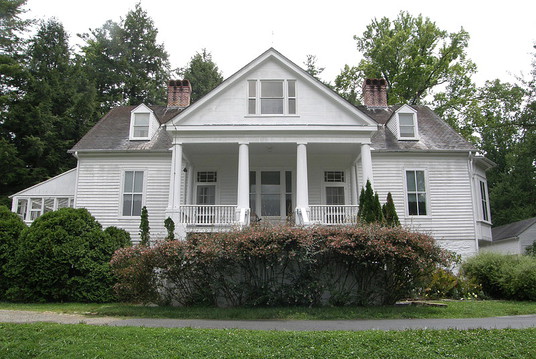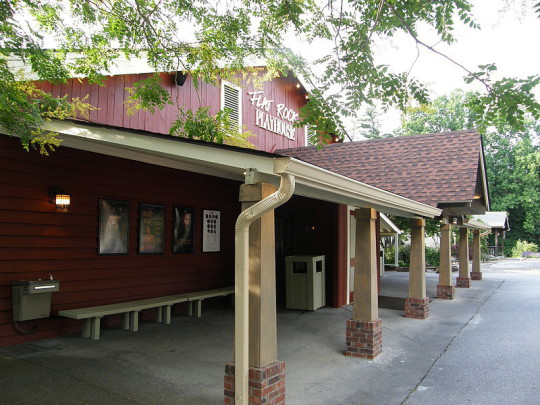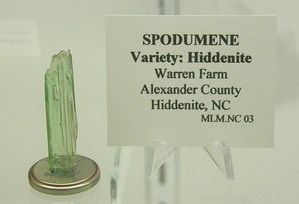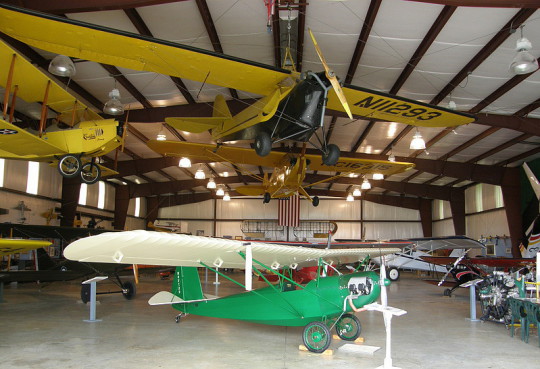HENDERSON COUNTY
Scroll down this page or click on specific site name to view features on the following Henderson County attractions/points of interest:
Carl Sandburg National Historic Site, Flat Rock Playhouse, Henderson County Heritage Museum, Holmes Educational State Forest, Johnson Farm, Minerals & Lapidary Museum of Henderson County, Western North Carolina Air Museum, Wolfe's Angel
Fast facts about Henderson County:
Created in 1838, the county is named for Leonard Henderson, a Chief Justice of the NC Supreme Court.
The county seat is Hendersonville. Other communities include Flat Rock, Fletcher, and Laurel Park.
Henderson County’s land area is 374 square miles; the population in the 2010 census was 106,740.
It is worth noting that the North Carolina General Assembly named the Flat Rock Playhouse the official state theater.
Flat Rock
For those with an interest in literature and the performing arts, the small community of Flat Rock packs a terrific one-two punch. During the day, visitors can enjoy exploring Connemara, the home of Pulitzer Prize-winning poet and writer Carl Sandburg; at night, they can venture across the street and take in a performance at the Flat Rock Playhouse, the official State Theatre of North Carolina. The Carl Sandburg House is a historic site operated by the National Park Service. The main house was built in 1839 as a summer home for Christopher Memminger of Charleston, SC. After passing through several owners, the property was on the market in 1945 when Lilian Sandburg, wife of the famed poet and biographer, happened upon it. Living in Michigan at the time, Mrs. Sandburg was anxious to find a place in a warmer climate suitable for raising her prized diary goats. Both husband and wife agreed that the estate, named “Connemara” by a previous owner, would fit their needs, and the couple bought the property in October, 1945.
Over the next two-and-a-half years, the Sandburgs made extensive changes to the Greek-Revival house, modernizing the heating, plumbing, and electrical systems, installing new chim-neys, bathrooms, and an indoor kitchen, and converting the old kitchen into a three-car garage. Connemara was home to Sandburg for the last 22 years of his life, and the so-called “poet of the people” published more than a third of his work while living here. He died of natural causes in 1967, whereupon Mrs. Sandburg sold the property to the federal government so that the house could be preserved as a memorial to her husband. Connemara opened to the public as a historic site in 1974, and visitors to the home today see it almost exactly as it looked when Sandburg was alive. Guided tours are given throughout the day and last approximately 30 minutes. In addition to the house, the site includes the dairy goat farm, where Lilian Sandburg’s famed champion Chikaming goats are still raised. There are also five miles of walking trails over moderate to steep terrain. The Carl Sandburg Home National Historic Site is open daily. Admission to the grounds, trails, and barn is free; a fee is charged for tours of the home.
Flat Rock
In an unassuming, red-frame building across the road from the Sandburg Historic Site is the Flat Rock Playhouse [FRP]. The weathervane atop the building is the figure of a vagabond, an appropriate symbol when one discovers the origins of the playhouse. In 1937, a group of New York City performers led by Robroy Farquhar organized themselves as the Vagabond Players. In 1940, they arrived in western North Carolina, where they found a warm welcome. Converting an old grist mill at Highland Lake into a makeshift playhouse, the group had a successful summer season, prompting their return the following year. At the end of World War II, the Vagabond Players reorganized and returned to the region, this time performing in a playhouse in Lake Summit. Success led to the need for a larger, permanent home. The group acquired an 8-acre tract of land in Flat Rock in 1952 and put on its shows under a rented “big top” until the current playhouse was constructed.
In 1961, the NC General Assembly officially designated Flat Rock Playhouse as The State Theatre of North Carolina. Over the years, the Playhouse has staged a variety of shows, from well-known Broadway dramas, musicals, and comedies, to lesser-known productions and an occasional world premiere. In 1962, Flat Rock Playhouse staged the first performance of The World of Carl Sandburg. Look Homeward, Angel, based on the famous novel by Thomas Wolfe, was performed in 1970. In 1994, Forever Plaid became FRP’s first fall production, and in 2000, the FRP’s season expanded to a full eight months with productions held in November and December. In recent years, FRP has added a second, more intimate, venue in downtown Henderson. The Playhouse also schedules a "Music on the Rock" series of summer concerts. 2014 FRP productions include My Fair Lady; Boeing, Boeing; Miss Siagon; A Funny Thing Happened on the Way to the Forum.
Hendersonville
The Henderson County Heritage Museum opened its doors for the first time in April, 2008, in a most appropriate place - the former courthouse building on the south end of Main Street in downtown Hendersonville. Several rooms of the fully-restored historic courthouse now feature displays and multimedia technology that tell the county's history, from the Cherokee and early pioneers to modern times. Individual rooms focus on specific periods: Wilderness to 1860; 1860 to 1920, and 1920 to the Present. Planned themes are rotated in these rooms, and topics include patriotism, culture, lifestyle, spiritual life, transportation, and recreation and tourism, among others. 828-694-1619
West of Hendersonville
Nestled in the Blue Ridge Mountains, roughly midway between Hendersonville and Brevard, is Holmes Educational State Forest. Highlights of this state-managed forest include the Talking Tree, Forest Management Demonstration, and Crab Creek trails, along with the small Discovery Center. The site also features excellent picnic facilities. The North Carolina system of educational state forests presently includes six centers statewide, of which Holmes is the westernmost. These managed forests can best be described as outdoor classrooms, teaching visitors about the complex ecosystems which comprise a forest and helping them gain a better understanding and appreciation of forests.
At Holmes, one means of educating the public is the Talking Tree Trail, a .45 mile, easy-to-moderate path that loops its way along a hillside of towering hardwoods, including black birch, yellow poplar, white oak, and American basswood. The trail takes about 45 minutes to walk, including time to stop and listen to the brief taped messages at several points along the way. The “talking” trees have names, speak in the “first person,” and tell visitors about themselves, their uses, their surroundings, and general history of the forest itself. Each tree has several different messages, so by pressing the play button several times, visitors will receive additional information.
The Forest Management Dem-onstration Trail, rated strenuous, is the longest hike, covering 3.5 miles and taking about two hours to walk. The Wildcat Rock Trail is slightly only a little more than half a mile in length, running between the Talking Tree and the Demonstration trails, but is very steep, has lots of steps, and is rated very strenuous. By contrast, the half-mile Crab Creek Trail is an easy, flat path. Along this trail visitors will see the fire control exhibit, featuring equipment associated with fighting forest fires – a Huey helicopter, a tractor/plow, and a fire tower. The site is equipped with modern restroom facilities, a large group picnic shelter, many individual picnic areas with tables and grills, and a group campground. From Hendersonville, take US 64 West. Drive 15 miles and turn left onto Crab Creek Road. Drive 6 miles. Entrance is on the right. Holmes Educational State Forest is open from mid-March until the Friday before Thanksgiving. Call the office for daily hours and additional information. 828-692-0100
Hendersonville
Hendersonville’s historic Johnson Farm is well worth a visit. Believed to be the first brick house in Henderson County, it was built over a four-year period beginning in 1884 for wealthy tobacco farmer Oliver Moss, newly arrived from South Carolina. Master builder Riley Barnett fashioned a fine country home for Moss, with many interesting touches. The bricks were fired on site from clay brought in from the nearby French Broad River. The walls are 18 inches thick. A thin coat of lime and brick dust, a mixture called “parge,” was smoothed over the exterior brick and then “penciled” to give the house a distinctive look of even, regular brick. The house features Italianate styling, including intricate scrollwork, a bay window, and hoods protecting the arched windows. Distinctive interior features include a quarter-turn stairway that rises three floors; a hall archway; and fireplaces with handsome mantels. In total, the house has seven fireplaces and five bedrooms.
Moss had purchased a 500-acre tract of land in 1884, but the tobacco market suffered a severe downturn, and Moss sold his house and 310 acres to Robert Leverett in 1888. Time passes. In 1913, Leverett’s daughter, Sallie L. Johnson, a widow with two children, was in need of income. She chose to convert the family home into a boarding house for tourists. From 1913 until 1958, the Johnson farm house was a popular tourist retreat, where lodgers paid $5 a week for a room and three meals a day. Sallie, with the help of her sons Vernon and Leander, operated the boarding house until her death in 1958. Vernon and Leander closed the house to the public at that time but, to help fill their time, they volunteered at West Henderson High School.
This, in turn, led to their donating land to the county for the building of Rugby Middle School. Upon the death of the two sons, the Johnson house and property was bequeathed to the Henderson County Board of Education with the intent that a heritage center would be developed. Their vision has been fulfilled, with numerous area children visiting the farm annually.
Dependencies include a gambrel-roofed barn, smokehouse, pig barn, chicken coop, and granary. A two-story, stand-alone annex was built in 1923 to provide additional rooms for guests; it included eleven bedrooms and two bathrooms. The annex is now home to the Heritage Weavers & Fiber Artists. This group offers classes and workshops for adults and special programs for children. The Johnson Farm is open to the public Tuesday through Friday from September through May, and Monday through Thursday from June through August. Guided tours are given at 10:30 AM. Admission charged. 828-891-6585
Hendersonville
In a very literal sense, a “cracking good time” can be had at the Mineral & Lapidary Museum of Henderson County. The Museum displays an assortment of minerals, gems, and fossils, and staff is on hand to crack open geodes to reveal what artistry nature may have created inside. Some of the Museum’s more general exhibits include a variety of fluorescent minerals displayed under black light and ultraviolet light; petrified wood; and minerals typically found in North Carolina, including hiddenite, a green-hued mineral found only in Alexander County. Among the more unusual items displayed are pieces of a meteorite found in Hendersonville in 1901; Hope Diamond replicas; and a 6-foot tall amethyst geode from Brazil. Hours are 1-5 Monday through Friday and 10-5 Saturday. Admission is free. 828-698-1977
Hendersonville
The Western North Carolina Air Museum is dedicated to the preservation and promotion of the region’s heritage of flight. The Museum began in 1989, operating out of an existing hanger at the Hendersonville airport. Since then, the organization has built two hangers for its collection. The Museum focuses on the first fifty years of flight, with an emphasis on aircraft from the “Golden Age of Aviation,” that is, the years surrounding World War II. The collection includes a 7/8-scale replica of the 1915 Nieuport II and the full-size 1916 British SE-5, both World War I fighter planes. The latter is armed with the Vickers machine gun, a wartime invention that synchronized the firing of the gun with the turning of the propeller, allowing bullets to pass through the spinning blades. If you’ve ever heard about “Wrong Way” Corrigan, you’ll enjoy seeing the type of Curtiss-Robin airplane he “accidentally” flew from New York to Ireland in 1938. Unable to receive permission for a trans-Atlantic flight, Corrigan took off from New York, supposedly to return to his home in California. Although a veteran aviator, Corrigan wound up in Ireland by mistake, citing equipment or pilot error as the reason. Corrigan’s unauthorized flight took 28 hours, and he became only the eighth man to fly across the Atlantic solo. Only two of the type aircraft Corrigan used in his memorable flight still exist, and the Hendersonville museum has one of them.
A plane with a local connection is the 1931 Aeronca Champ. With a weight of only 446 pounds and a cruising speed of 65 MPH, an aircraft of this type was used by Rock Hill, S. C. aviator Bob Bryant to set a world non-stop distance record in 1936. Bryant flew from Rock Hill to Miami, Florida in 9 hours and 41 minutes. The Museum also features several airplanes from the 1930s and 40s designed for pilot training, including early Piper models.
Aviation enthusiasts, very often pilots themselves, staff the Museum, and they are quick to answer questions, provide details, and share stories about the planes on display. Circumstances permitting, visitors might have an opportunity to spend time in the facility’s second hanger. Among the aircraft housed here are vintage bi-planes, used by the Army and Navy during World War II for flight training. After the war, their ease of handling and maneuverability made these planes ideal for use as crop dusters. The oddest craft in this hanger, however, is the Museum’s Ornithoper, a pre-Wright Brothers design that used a small motor to move wings that flapped. Although the craft never took off, it’s an interesting look back at the experiments in flying that preceded Orville and Wilbur’s famed first flight. To get to the Museum, take Exit 22 off I-26 and turn west onto Upward Road. Turn right onto NC 176 (Spartanburg Highway), right on Shepherd St., and left on Brooklyn Ave. The Air Museum will be on your right. The Museum is open Sunday and Wednesday 12-6 and Saturday from 10-6, March through October. November through February, it is open 12-5 Saturday, Sunday, and Wednesday. Admission is free; donations accepted. 828-698-2482
Hendersonville
Look Homeward, Angel was the name of Asheville native Thomas Wolfe’s first novel, and the title has led to speculation over the years as to whether the image of a homeward-looking angel was inspired by one of the figures carved by Wolfe’s father, a stone cutter by trade. A particularly striking statue of a wistful-looking angel stands over a gravesite in a cemetery in Hendersonville; her right hand points toward the heavens. Popular opinion is that this figure made such an indelible impression on the author as a child that he used it as the title for his thinly-veiled autobiography. Enough credence has been given to the story that the state placed a historic highway marker at the side of the road, identifying the statue as “Wolfe’s Angel.” Another statue that some think served as the author’s inspiration stands in a cemetery in Old Fort in McDowell County.
Henderson County is bordered by BUNCOMBE (Region Ten), POLK, RUTHERFORD, and TRANSYLVANIA (Region Ten).
Return to REGION NINE HOME PAGE.
Return to GEOGRAPHIC REGIONS HOME PAGE.



















